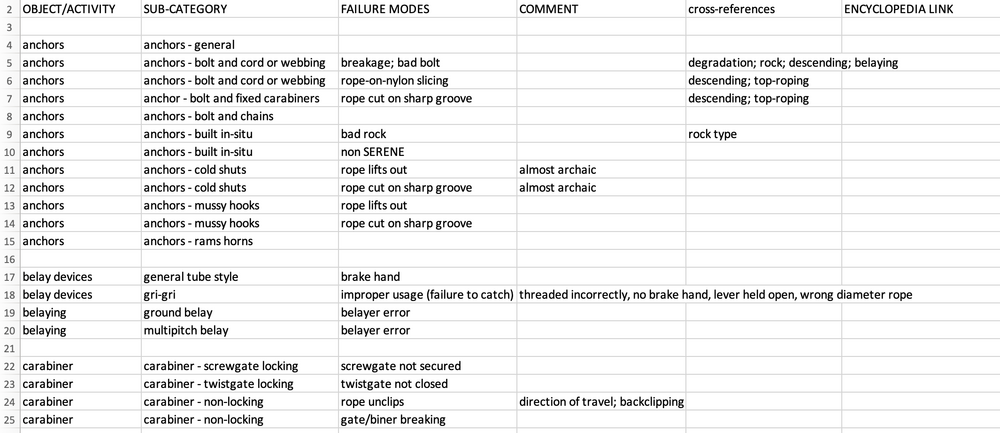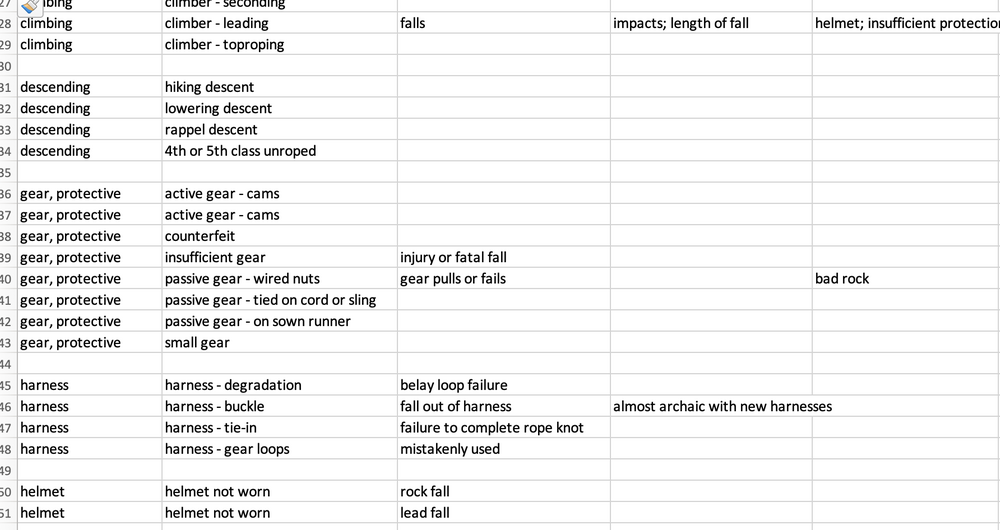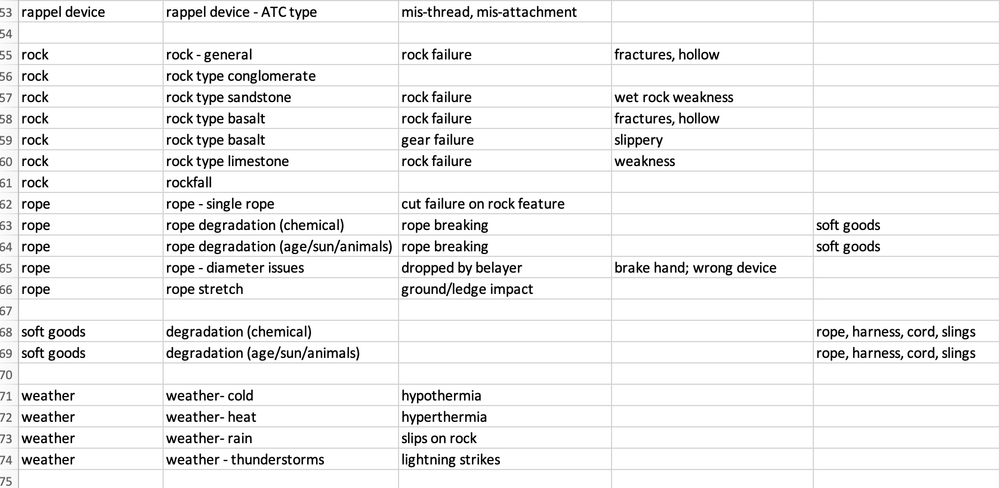Encyclopedia of Failure Modes
|
|
Periodically (too often it seems), I read about a serious or fatal accident and think to myself “They didn’t know what they didn’t know”. I know I’m far from the only person to have this reaction – I’ve read the same comment from others in the Forum. There are ample resources available to educate climbers in what they need to know to enhance their safety: professional guides, experienced mentors, books, publications like Accidents in NA Climbing, youtube instructional videos, detailed threads. And yet maybe a resource is still missing. I had an idea that it might be helpful to construct a crowd-sourced “Encyclopedia of Failure Modes” that could live on the Internet and be available to anyone. I don’t envision this as being an exhaustive “how-to” in any way, but just a succinct description of failure modes and few words on remedies, but with references at the bottom of each entry consisting of hyperlinks that would take people to a variety of sources: Descriptions of accidents that are examples of the failure mode, Forum Threads, how-to books, videos, etc. As the “gateway” to the Encyclopedia, I envision an index (maybe constructed as a relational database?), that people could peruse that would alert them to an unknown to them failure mode. Each Failure Mode entry in the Index would have a link that would take them to the page in the Encyclopedia (which would then in turn route the reader to external sources as per above). Whatever the format, it would have to be something easy and obvious to use. In the post that follows this one, I have given an example of the index (produced using Excel for simplicity). Perhaps a relational database would help solve the issue with cross connectivity of terms/keywords that is cumbersome to organize using Excel? This example is obviously not comprehensive, it’s just the obvious stuff that came out of my head. In the third post, I’ve given a few examples of an Encyclopedia entry. I’m interested in hearing if people think this would be useful. I personally know very little about the world of computers and the internet. Unknowns to me: What would be involved in actually getting this constructed in a crowd-sourced way? Is direct crowd-sourcing feasible or would this be too prone to error, chaos, and hacking of some sort? Should there instead be an editorial or administrative team that would incorporate submissions into both resources? Where would the best place be for both Index and Encyclopedia to live? Could we just buy a domain and have the domain linked as a sticky on MP? Since AAC publishes ANAM, would it make sense for their website to be the hosts? Would the community support their involvement? AAC hosting would allow for continuity over time, but would they be willing to be involved? Let’s hear people’s ideas. If people like the idea, aybe we could put together a small working group, not of climbing content experts at this point, but of people who have a clue how to proceed operationally. Perhaps most valuable initially would be Project Managers, computer experts and database people. Lastly, I don’t particularly want “ownership” of this idea or project, frankly, I’d rather use my remaining time on earth to play. I’d be really happy if some person with the knowledge, experience, skills and energy would take this idea and spearhead it. But if no one wants to take that on, I would be happy to stay involved for a while to help organize, co-ordinate, and even provide some $$ if we needed a virtual place to work as a team and that was not free. |
|
|
|
|
|
ANCHORS – GENERAL There are many recorded fatalities associated with anchor failure. These incidents occur with both fixed anchors of all types and climber-constructed anchors. Cross-reference to specific anchor types, rock failure, gear failure, soft goods failure. Numerous resources regarding anchors and anchor construction are available. As example see: http://falcon.com/books/978076278207 ANCHORS – MUSSY HOOKS Many climbers remain unaware that these anchors, which are non-locking and typically installed with gates aligned facing outward, have a failure mode which can and has resulted in several deaths. Under circumstances of twists or kinks in the rope, or climber moving above the hooks, the rope can become completely unattached from the anchor. This same failure mode was known for their archaic predecessor, the cold shut (open shut). The climber and climber’s rope should always remain positioned below the hook. Mussy hooks are meant for convenience in lowering, not for top-roping. As in all lowering and rappelling situations, it is imperative to weight test the security and set-up of the lower or rappel before removing your backup tethers. Additionally, as with all fixed hooks and carabiners, the hooks should be inspected for sharp grooves created by wear and tear. For safety, do not lower on sharply grooved mussys. Use your judgment about rappelling with the rope through sharply grooved fixed gear. Links: https://www.youtube.com/watch?v=4N_N4g2oK1E&t=167s BELAYING – BELAYER ERROR Belayer error has resulted in innumerable injuries to lead climbers. Does your belayer understand: paying attention/no distractions, proper use of their belay device, rope diameter considerations, where to stand when belaying and why, anchored vs. non-anchored belaying considerations, rope stretch considerations, soft catch technique, when soft catch is contraindicated, lowering (rope length dangers)? Links: ROCK FAILURE Climbers should educate themselves to the type of rock and to its salient physical properties in the climbing area they are using. Most guidebooks have this description in the introduction. Rock failure can result in lead falls and, less commonly, anchor failure. Climbers experience rock failure while leading in a variety of circumstances, such as: hold or entire rock feature detaching under hand or foot pressure, gear pulling because of rock failure under lead fall force (either climber gear or anchor gear). Experienced climbers are always alert to signs of bad, fractured or hollow rock. Rockfall is a subset of rock failure. Rock failure is a not uncommon contributing factor, or outright cause, of climber injury and fatalities. See the entry for specific rock types for more info on failures typical of that rock. Rock breakage links: Rockfall links: https://www.mountainproject.com/forum/topic/122716646/twin-sisters-wizards-gate-rock-fall-death ROPE STRETCH Lead ropes used for climbing are dynamic ropes: they are engineered to stretch when they feel the force of a falling climber. This elasticity distributes the energy generated by the fall, decreasing the force on the rope itself, the protective gear, the belayer (if belaying directly off harness), and most importantly, the falling climber. Rope stretch can be used to the climber’s advantage when used to deliver a “soft catch”, but it has also resulted in injury to falling climbers in various circumstances. The most common cause of injury with rope stretch occurs near the ground when stretch results in a ground fall, but rock impact (and injury) due to rope stretch also occurs with impact onto rock features such as sloping ramps below roofs. Links: https://www.mountainproject.com/forum/topic/105947476/information-about-mike-mcglynns-accident SOFT GOODS – DEGRADATION (SUN/AGE/ANIMALS) Soft goods critical to safety in climbing include rope, harness, sling and accessory cord. All of these decay slowly with age over time but this decay can be greatly accelerated if the soft good is exposed to the natural environment, especially sun exposure. Usage itself (wear and tear) also contributes to a decrease in physical strength of the soft good. Please see the entry for each of the soft goods mentioned for examples of failures which have resulted in injury and death of the climber. Links: http://www.supertopo.com/climbers-forum/1933713/Todd-Skinners-failed-harness-update https://www.climbing.com/news/broken-sling-caused-tahquitz-double-fatality/
|
|
|
Yep, from a technical point of view you'll want something like Wikipedia instead of making your own software for this. It'll also allow anyone to edit. |
|
|
J Lwrote: How about Google sheets? There are hundreds of “failure modes” but only a few that matter. Won’t they get lost in minutia of a spreadsheet? |
|
|
nirot glover wrote: nirot the bot. That rhymes! |
|
|
Tradibanwrote: Precisely. If someone goes to the spreadsheet and sees a densely packed forty page spreadsheet, their eyes will glaze over. You also can't link directly to any specific cell in a spreadsheet (as far as I know). |
|
|
Tradibanwrote: Agreed. This could be addressed though with an entry for "occurrence level" with the number or percent of occurrences. I'd be interested to see the combined occurrence level for everything beyond the big three: Rappelling, lowered off end of rope, and unfinished knot. |
|
|
John Luke Lusty wrote: Thank you! I didn’t even realize this existed. This might be the best option. I’ll try to get something started there as I have time, and post the link here to see if it gets some traction for contributions and links to external resources. |
|
|
Kent Peasewrote: Kent, ANAC does this periodically. I’ll have to search through my old volumes to see the last tabulation. But IIRC lead falls, combined with insufficient gear, gear failure, was maybe higher than the things you mentioned. |
|
|
I've had the same idea and would be happy to contribute. In addition to being easier to read than accident reports, an encyclopedia would be able to document failure modes before they've resulted in a accident. I agree a wiki format would be best. |
|
|
J Lwrote: You can sort a spreadsheet. |
|
|
I spent some time today slogging through the Wikibooks user guide and I don't think that Wikibooks is going to work. The main reason is that they are very clear that WIKIBOOKS is very different in concept to WIKIPEDIA. The main problem is that "they" expect/require Wikibooks to have very few links, and that the book should for the most part be self-contained. Quote: "Relying on too many links means that your book isn't covering the material as well as it should." I doubt any of us has the time/ desire to cover the material as well as it could be covered. IMO, the benefit of a lollopalooza of links is that there has already been so much climbing content developed. Why regurgitate that, esp. when so much of it is already available in book, article, and video format? So that leaves making a page in Wikipedia itself, which would work OK I think. The page would maybe be called "Rock Climbing Dangers"? And have as many sections as people want. We could present the sections in alphabetical order so that it's more like an encyclopedia-on-a-page than an article. Most Wikipedia entries read like journal articles. I did some preliminary searching, and there doesn't seem to be anything similar to that at present. If you look under specific rock climbing topics, like rappelling (which exists under abseilling), you do find a few words about danger. Similarly, there is a page for lead climbing, and that says a few words about runouts, gear etc. I'm out climbing all day tomorrow, but I'll try to do more exploration of what already is available on Wikipedia later in the week. Preliminarily, it does seem like a page which consolidates all the "dangers" in one place could be useful. Serge, thanks so much for an offer to help! Edited to say, Serge I sent you a PM, check your spam if you don't see it. |
|
|
PM replied. |
|
|
I imagine that the AAC already keeps detailed records of any and all climbing accidents known to them, given they are able to publish statistics on rates of climbing accidents, etc. However that is locked (rightfully so) behind membership. The great thing about this project would be that it'd be a collection of the "open source" recollections of climbing accidents, which in and of itself has value. However, I would caution against Wikipedia. While it is a very valuable resource, Wikipedia editors are often petty and control certain "fiefdoms" within. It could be that your collection of articles skirts under the radar for weeks or months, and then are suddenly deleted wholesale because they are "non-notable", "lack sources", or simply that they are part of a list, and not an article about a single subject. Yes, it is ironic that in a virtual encyclopedia that contains lists — many of them, even — you can get your new article deleted for being a list or part of one. For example, if you created an entry for the Sand Rocks mussy hook incident, it may be "speedy deleted" for being non-notable. I am only one voice, and you may disregard my warning. I just have been burned by this in the past. |
|
|
I think this is a great idea - maybe some sort of moderator/owners that vet submissions and edits, like on a reddit thread for example. This existing behind a paywall disadvantages the climbers that it would most benefit. the resource is needed most by new/inexperienced outdoor climbers that are unlikely to shell out $$ early on for a hobby/community they are just getting into. There are a number of YouTubers/content creators that create videos analyzing accident report so there is already media out there that could benefit from being catalogued in a user-friendly encyclopedia. |
|
|
Written documentation is great. I think people also learn well by doing, so it helps to practice many such things hands on and then practice more in the field. One good spot for a number of lessons is a belay station just a few feet off the ground. For instance, Placing gear is best practiced hands on, not on paper. If you are top roping a very long route, a lesson on rope stretch will really sink in by safely practicing a fall from 6 feet up. It helps to fully bounce on the rope, to take out some of the stretch. In terms of links to additional information, I recommend only linking to well edited sources. For instance, there are a million poorly filmed and poorly edited photos and videos that are very lacking. |
|
|
Great input, thanks. Julian, Serge others cautioning about using wikipedia itself, thank you. I’m going to liase with Serge off line about other wiki type options he’s suggesting and see what is available what would be easiest for people to contribute. |
|
|
On the topic of technical hosting of the wiki, MediaWiki is pretty feature packed but I've heard that something slimmer like XWiki might be closer to your needs. https://www.xwiki.org/xwiki/bin/view/Main/WebHome |
|
|
I initially voted for a wiki-style format but am now having 2nd thoughts. 1st, it's harder to browse a wiki than scan through a list. 2nd, a wiki format raises the expectation of the amount of text to write, possibly discouraging participation. In writing down my own items (which I now have 85 of), I've found a 2-column spreadsheet format most natural (1-line description + link to more info) . It also makes it easier to notice/merge duplicates. |
|
|
Serge Swrote: Both may be useful. They may complement each other. Let’s compare notes in January. I’m making slow progress but only about 1/3 through on the more article style format. |

 Continue with onX Maps
Continue with onX Maps Sign in with Facebook
Sign in with Facebook

























